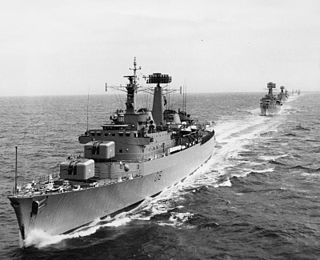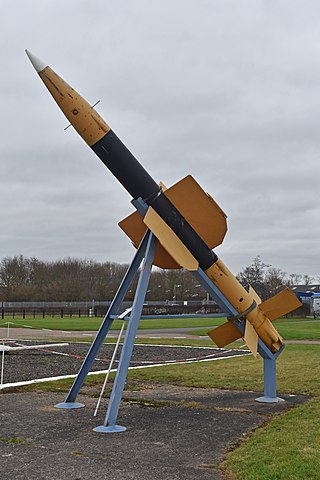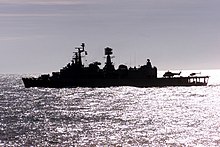
HMS Edinburgh was a Type 42 destroyer of the Royal Navy. Edinburgh was built by Cammell Laird of Birkenhead. She was launched on 14 April 1983 and commissioned on 17 December 1985. The largest of the Type 42 destroyers, Edinburgh was known as the "Fortress of the Sea". Edinburgh was the last of the Type 42 destroyer to serve in the Royal Navy and was decommissioned on 6 June 2013.

HMS Norfolk was a County-class destroyer of the Royal Navy. She was the fourth Group 2 and the last of the County-class built.

The County class was a class of British guided missile destroyers, the first such warships built by the Royal Navy. Designed specifically around the Seaslug anti-aircraft missile system, the primary role of these ships was area air defence around the aircraft carrier task force in the nuclear-war environment.

The Type 21 frigate, or Amazon-class frigate, was a British Royal Navy general-purpose escort that was designed in the late 1960s, built in the 1970s and served throughout the 1980s into the 1990s.

HMS Exeter was a Type 42 destroyer, the fifth ship of the Royal Navy to be named Exeter, after the city of Exeter in Devon. The vessel fought in the Falklands War and the first Gulf War, she was scrapped in 2011.

HMS Antrim was a County-class destroyer of the British Royal Navy launched on 19 October 1967. In the Falklands War, she was the flagship for the recovery of South Georgia, participating in the first ever anti-submarine operation successfully conducted exclusively by helicopters. In 1984, she was commissioned into the Chilean Navy, and renamed Almirante Cochrane.

HMS Devonshire was the first of the County-class destroyers and the first Batch 1 ship of the Royal Navy. The ship was built by Cammell Laird in Birkenhead near Liverpool. With a displacement of 6,200 tons full load, Devonshire was named after the English county of Devon. She was launched on 10 June 1960 and delivered to the navy two years later.

HMS Glamorgan was a County-class destroyer of the Royal Navy with a displacement of 5,440 tonnes. The ship was built by Vickers-Armstrongs in Newcastle Upon Tyne and named after the Welsh county of Glamorgan.

HMS Hampshire was a County-class destroyer of the Royal Navy. Laid down, in March 1959 a couple of weeks behind the class leader Devonshire, she was classified as a guided missile destroyer, as the Sea Lords regarded the concept of the cruiser and big gun ship as discredited by the perceived failure of the Tiger class and the obsolescence of the heavy gun. The description of guided missile destroyer seemed more likely to win approval from the Treasury and Government for an adequate number of warships the size of small cruisers, which could play many traditional cruiser flagship and command functions, but had no armour around its gun and missile magazine.

HMS Kent was a batch-1 County-class destroyer of the Royal Navy. She and her sisters were equipped with the Sea Slug Mk-1 medium-range surface-to-air missile SAM system, along with the short-range Sea Cat SAM, two twin 4.5-inch gun turrets, two single 20mm cannon, ASW torpedo tubes, and a platform and hangar that allowed her to operate one Wessex helicopter. The County class were large ships, with good seakeeping abilities and long range, and were ideal blue-water ships for their time.

HMS London was a County-class destroyer of the Royal Navy.

HMS Bristol (D23) was a Type 82 destroyer, the only vessel of her class to be built for the Royal Navy. Bristol was intended to be the first of a class of large destroyers to escort the CVA-01 aircraft carriers projected to come into service in the early 1970s but the rest of the class and the CVA-01 carriers were cancelled as a result of the 1966 Defence White Paper which cut defence spending.

The Battle class were a class of destroyers of the British Royal Navy (RN) and Royal Australian Navy (RAN), named after naval or other battles fought by British or English forces. Built in three groups, the first group were ordered under the 1942 naval estimates. A modified second and third group, together with two ships of an extended design were planned for the 1943 and 1944 estimates. Most of these ships were cancelled when it became apparent that the war was being won and the ships would not be required, although two ships of the third group, ordered for the RAN, were not cancelled and were subsequently completed in Australia.

HMS Ariadne was a Leander-class frigate of the Royal Navy. She was launched in 1971, was sold to Chile in 1992 and sunk as a target hulk in 2004.

The Type 82 or Bristol-class destroyer was a 1960s guided missile destroyer design intended to replace County-class destroyers in the Royal Navy. Originally eight warships were planned to provide area air-defence for the four planned CVA-01 aircraft carriers. They would also have been able to operate independently as modern cruisers "East of Suez".

Seaslug was a first-generation surface-to-air missile designed by Armstrong Whitworth for use by the Royal Navy. Tracing its history as far back as 1943's LOPGAP design, it came into operational service in 1961 and was still in use at the time of the Falklands War in 1982.

HMCS Vancouver, was a Thornycroft S-class destroyer, formerly HMS Toreador built for the Royal Navy in 1917–1919. Seeing limited service with the Royal Navy, the ship was loaned to the Royal Canadian Navy in March 1928. The destroyer served primarily as a training vessel until 1936 when the vessel was discarded.

HMS Duncan is the sixth and last of the Type 45 or Daring-class air-defence destroyers built for the Royal Navy and launched in 2010. Duncan is named after Adam Duncan, 1st Viscount Duncan, who defeated the Dutch fleet at the Battle of Camperdown on 11 October 1797. The destroyer has served in the Mediterranean, Black, and Caribbean Seas, and in 2019 was deployed to the Persian Gulf in response to increased tensions with Iran in the region.

HMCS Kootenay was a Restigouche-class destroyer escort that served in the Royal Canadian Navy and Canadian Forces from 1959 until 1996. She was the fifth ship in her class and the second vessel to carry the designation HMCS Kootenay. The ship suffered two serious incidents in her career: a 1969 explosion and ensuing fire that killed nine, and a 1989 collision that required the complete replacement of her bow. Following her service, the ship was sunk as an artificial reef.

HMS Acheron was an A-class destroyer of the Royal Navy. She served during the Second World War in Home waters and off the Norwegian coast, before becoming an early war loss when she sank after hitting a mine off the Isle of Wight on 17 December 1940. The wreck site is designated under the Protection of Military Remains Act 1986.






















